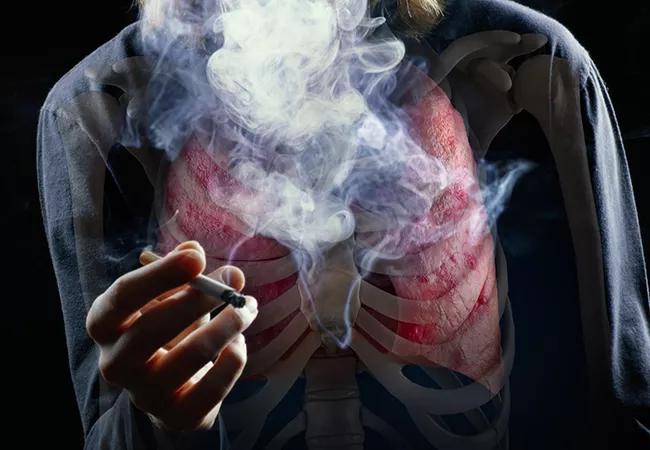Long-term lung allograft outcomes clinically unaffected by organ exposure, study finds

Donor lungs that are otherwise appropriate for transplantation should not be rejected solely due to donor smoking or substance use, concludes a large database study from Cleveland Clinic researchers.
Advertisement
Cleveland Clinic is a non-profit academic medical center. Advertising on our site helps support our mission. We do not endorse non-Cleveland Clinic products or services. Policy
“We found no association between donor smoking history, pack-years or substance use with primary graft dysfunction,” says Kenneth McCurry, MD, Surgical Director of Lung Transplantation at Cleveland Clinic and co-author of the study, published in the Journal of Thoracic and Cardiovascular Surgery. “While donor smoking history was linked to a statistically significant reduction in forced expiratory volume in 1 second (FEV1) in double lung transplant recipients one year after transplant, this effect was not clinically significant.”
The number of donor lungs available for transplantation is limited, which makes it crucial to strike the right balance between avoiding unnecessary limits on the donor pool and still identifying the most suitable donors. Few data have been published, however, on the impact on post-transplant outcomes of donor smoking or substance use.
To help fill that gap, Cleveland Clinic researchers performed a retrospective study looking at the effect of donor smoking status, pack-years or substance use on allograft function and survival after lung transplant. “We used a large database from our own institution to address a key issue in lung donor selection,” says study co-author Marie Budev, DO, MPH, Medical Director of Lung Transplantation.
The researchers analyzed 1,366 lung transplants from 1,291 donors that were performed among 1,352 recipients at Cleveland Clinic between January 2007 and February 2020. Information on donor history of tobacco, alcohol and substance use was taken from Uniform Donor Risk Assessment Interviews and medical records. All potential donors were evaluated for quality by at least two physicians, including a surgeon and pulmonologist.
Advertisement
The endpoints the authors assessed in the transplant recipients were post-transplant primary graft dysfunction, longitudinal FEV1 on spirometry and survival.
Median ages of donors and transplant recipients were 39 and 61 years, respectively. Nearly half (49%) of the recipients had received lungs from smokers and 25% had received an organ from a donor with a 20 pack-year or more smoking history (median pack-years = 8).
Just over half (51%) of the lungs transplanted were from donors who were substance users. The most common substance used was marijuana (34%), followed by intravenous drugs (29%) and heavy alcohol use (intake of two or more drinks per day) (17%).
Overall, the researchers found no association between donor smoking, pack-years of smoking or substance use and primary graft dysfunction at any time point. At one year after transplant, FEV1 was 74% of predicted in recipients whose donors were nonsmokers versus 70% in recipients whose donors were smokers; the difference was driven largely by FEV1 outcomes among patients receiving double lung transplant: 77% versus 73%, respectively (P = .0002).
“Our analysis showed that donor smoking was associated with a statistically significant but clinically insignificant lower recipient FEV1 after double-lung transplant,” says Dr. Budev. “There was also no quantitative relationship between pack-years of smoking and FEV1.”
Non-risk-adjusted survival at five years after transplant was slightly but not significantly lower in recipients with donors who had smoked versus donors who had not smoked (54% vs. 59%; P = .09). As donor pack-years increased, recipient survival incrementally decreased, and the effect was most pronounced at five years (P = .01).
Advertisement
“Our study adds to the evidence that lungs from well-selected donors can have comparable recipient allograft function and survival regardless of smoking status, even with substantial pack-years,” notes Dr. Budev.
Donor substance use generally showed no association with recipients’ longitudinal FEV1, although non-risk-adjusted survival was higher when donors were not substance users (P = .03).
One limitation to the study’s generalizability is the fact that all the lungs from smokers and substance users had been deemed acceptable for transplant and were actually used. (At Cleveland Clinic, lungs that appear without pathology, regardless of the donor’s smoking or substance use history, may be used for transplant.) Thus, the dataset did not include lungs rejected at the initial evaluation or that were ultimately not transplanted after being seen on site.
Nevertheless, according to Dr. McCurry, the study’s clinical message is that smoking or substance use should not preclude use of organs from appropriate donors. “Allograft function after double lung transplant is negatively affected by donor smoking, but the reduction is minimal,” he says. “Given the limited pool of donors, remaining on the ever-growing waitlist is a greater risk for death than receiving an organ from donor who was a smoker.”
Advertisement
Advertisement

Insights on bringing Cleveland Clinic even closer to becoming the best transplant enterprise in the world

Consensus statement aims to increase use of the perfusion technology and raise transplant volumes

Minimally invasive approach, peri- and postoperative protocols reduce risk and recovery time for these rare, magnanimous two-time donors

Minimally invasive pancreas-kidney replacement reduces patient’s pain, expedites recovery

Largest study to date confirms mortality rates similar to DBD transplant and reveals risk factors

Patient receives liver transplant and a new lease on life

More than 30% of patients die when early dialysis is needed after surgery

AHA recommendations for pretransplant evaluation, peritransplant and long-term management